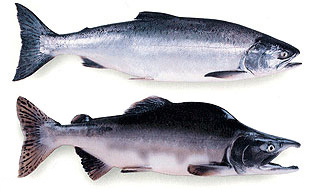
Southeast Alaska’s pink salmon harvest is turning out to be what managers expected but where the fish are returning isn’t consistent. KFSK’s Angela Denning reports from Petersburg:
Southeast’s pink salmon harvest looks like it will reach the State’s 18 million fish forecast. It’s close to the peak of the run and the harvest is just over 10 million fish.
The harvest range is predicted to be between 15 to 26 million.
“It looks highly likely that we’ll end up in the forecast range,” said Andrew Piston, the Alaska Department of Fish and Game’s Pink and Chum Project Leader for Southeast Alaska. “Overall, there’s been poor pink salmon returns in much of northern Southeast Alaska so the bulk of the harvest is occurring in southern Southeast Alaska.”
While there has been little harvest in the northern areas, the southern harvests are tracking close to the 10-year average.
It’s not exactly clear why northern Southeast is seeing a poor pink return. Pink salmon usually return to spawn at two years of age. Those parent year escapement numbers are calculated into the State’s forecast formula. And Piston says in 2017 those parent numbers looked strong.
But that’s not the whole story. Salmon might return to spawn but their young don’t always make it out of those streams.
Just last year, the State started partnering with the National Oceanic and Atmospheric Administration (NOAA) to also look at the juvenile pink salmon leaving the streams. NOAA has been gathering that data for a few decades through trawl surveys. Piston says it’s showing a correlation between the number of juveniles leaving the streams and the number of adults returning the very next year. That’s the case this season as well. While there were strong pink escapements in 2017, there were very low numbers of juveniles leaving streams in northern southeast last year.
“They probably had poor survival in the fresh water and early marine environment because there were just not a lot of juveniles even heading out to the ocean,” Piston said.
During the season, state managers track the pink salmon population by looking at seine harvests. They’ve been doing that since the 1960s. They have also gathered other harvest records going back to the late 1800s. Piston says pinks are like other salmon species in that their populations have fluctuated a lot over the decades.
“Pink salmon runs were really low in the 50, 60s, and 70s, and then they increased dramatically in the 1980s and they kind of reached peak average harvest levels in the mid to late 90s, early 2000s and since that time the average harvest has been trending downwards,” Piston said.
As the pink salmon run continues in Southeast and managers gather harvests data more will be known about the pink season overall. But as it stands, fishermen in the southern areas are seeing a much better year than their northern neighbors.









